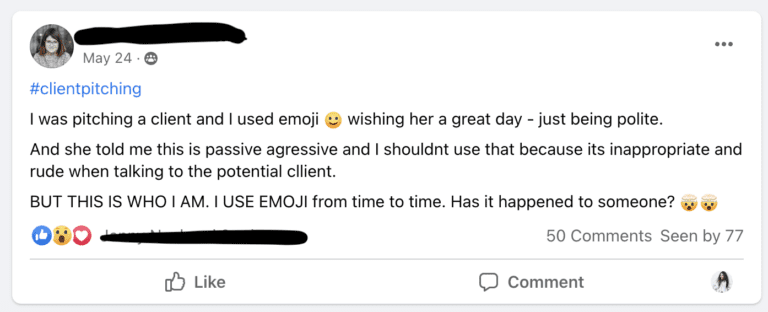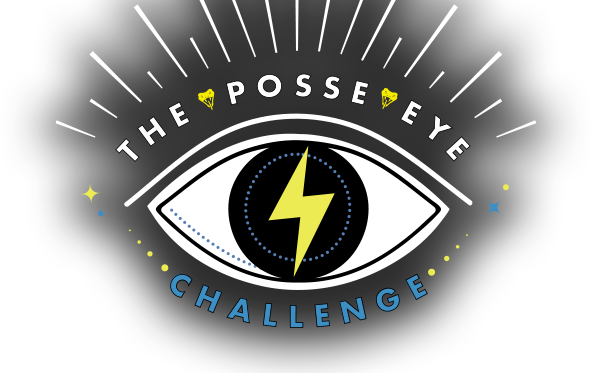Love ‘em or hate ‘em…
If you want to stay relevant, engage new leads, and sell your products or services online…
Then you better be using them…
Yep. I’m talking about…
EMOJIS.
In this article, I’m going to break down 3 REASONS WHY you absolutely need to be utilizing emojis in your branding, marketing, and content communications alike…
And most importantly… How NOT to use them.
We’ll cover that at the end, so stay tuned…
Hey Posse! What’s up? It’s Alex.
Coming at ya this week with a fresh tutorial all about one of the most controversial forms of communication – yup the emoji!
Now you might be thinking – “What?! How on earth could these little nuggets of expression be controversial?”
Well, I personally love emojis. In fact, I have hired writers based on their use of emojis in their copy (true story). But, one of my Reign Makers recently had a different experience…
Here’s a post she recently shared in our private members’ group…
This literally shook me. Are there really people out there who don’t like emojis?! I have to know, comment below and let me know your stance…
In this blog, I’m going to be sharing 3 REASONS WHY I believe you absolutely need to be utilizing emojis in your branding, marketing, and content communications…
But first, if you’re new to the crew – welcome!
Here on my website, you’ll find hundreds of copywriting, freelancing, and digital marketing tips & tricks to help you start, grow & scale your online business.
- Covering things like in-depth marketing strategies…
- Step-by-step sales page formulas…
- How to write the perfect social media captions…
- Finding your dream clients…
And hundreds more in between!
So if that’s the kind of stuff you want to learn more about, make sure you join my newsletter to learn when my next tutorial goes live.
Alright now, let’s get into it.
Regardless of which side of the emoji spectrum you fall on, one thing is absolutely certain.
Emojis have become a common language of the modern era.
There’s an emoji to express your every emotion, to rep your favorite food, and even to give your friends a virtual fist-bump. We use them when we’re texting our besties in the group chat. We sprinkle them into our workplace emails to make sure we’re not coming across as rude.
And we even use them to represent our body parts….
(Yep. I’m looking at you + ).
But besides being a fun and cheeky way to spare us from finger fatigue…
WHY exactly are emojis so important for copywriters and digital marketers?
Well, let me tell ya…
The first reason you need to use emojis in your marketing efforts is…
1. Emojis keep you relevant.
Evolving with the times, emojis are becoming more relevant to our lived realities. They are symbols of culture, with the sole purpose of expressing a mood, a notion, or a concept.
When COVID-19 hit the world by storm – emojis became a symbol we used to feel more connected to our peers, during a time when we were less connected than ever before.
Apple even went as far as to update its “Face with Medical Mask” to bear a smile underneath, with friendlier eyes, eyebrows, and rosy cheeks…
And while subtle additions to these faces bring comfort and connection — the use of the emoji can be even more meaningful and impactful. Like how the “Raised Fist” icon used in the Black Lives Matter movement has now come to represent solidarity against racism and police brutality.
And as our world continues to turn and change, so does the official emoji lexicon.
New emojis – like interracial couples and a bearded woman help to deepen our connection with more people about the things that matter most. As these icons become more inclusive, accurate, and relevant they become even better conduits of expression…
And as writers, expression – and connection – is the name of the game.
And speaking of connection, that brings me to the next point:
2. Emojis light up our brains.
According to science, when we look at a smiley face on our screens our brain responds as if we were looking at a real human face… with the same areas being activated.
The digital faces we see can even change our mood and lead us to mimic the same emotion (something we do in real life human interactions).
So if you need another motive to smile in both your real and digital life — look no further. Because it turns out, smiling is contagious whether it’s online or offline.
In marketing specifically, studies have shown that emojis play an important role in getting attention, enhancing consumers’ experience, and even their willingness to purchase something…
Basically… emojis matter.
They aren’t just silly stand-ins, fillers, or annoying symbols used by pre-teens on TikTok. With subtle psychological impacts on your readers, they hold a real superpower for connection and persuasion – so use them wisely.
Alright, next reason…
3. Emojis are accessible.
Being wary of very real cultural differences and nuances — emojis can actually help transcend language barriers. This is not to minimize the importance of the written word – but what makes emojis so great is their ability to be understood on a universal level.
These icons are pretty easy to understand without much thought – no translation or explanation needed.
And when accompanied with text, they can provide readers with the important clues they need to help process meaning … or solidify and clarify a message.
For writers, the cues that emojis provide can accompany our words skillfully, bringing the extra personality and pizazz that we intended to convey in the first place. They can also do it in a pinch, quickly steering a mood without wordy or overwhelming text.
And since their eye-catching attributes make them ideal for grabbing the attention of more readers — they can help us reach more people with our words …. and isn’t that the whole point?
And hey speaking of grabbing more attention.
Here are some stats that prove emojis are effective at doing just that…
- On Facebook, posts with emojis get 57% more likes, 33% more comments, and 33% more shares.
- On Instagram 50% of all comments and captions contain emojis
- And on Twitter, tweets with emojis get 25.4% more engagement
- In fact, one study analyzed 31 million tweets and half a million Facebook posts to find that emojis were a common factor in predicting social status and influence
- Over 50% of emoji users are more likely to engage with brands that are using emojis online
Now if those stats don’t convince you that the all-powerful emoji can enhance your marketing and branding efforts, then I don’t think anything will…
But before you start adding 1000 emojis to your next email…
Remember that there’s a right way to use emojis.
And there’s a wrong way…
Best Practices for Emojis in Copywriting
Before you go off the rails adding emojis to everything, you’ll wanna remember these 3 emoji marketing rules.
#1. DON’T put them just anywhere
Sure, the occasional emoji in the middle of a sentence isn’t the end of the world… but you definitely don’t want to make a habit out of it.
When using emojis remember to utilize them like punctuation marks – ideally at the end of a sentence.
#2. DON’T use them to replace words
Sure, a picture is worth 1000 words… but emojis are meant to help emphasize a message… not communicate it solely. When the only thing you’re using is emojis, you open the door for misunderstanding – which is definitely not what you want.
So always use words to communicate your message. Then add in your emojis for the emotional flare where you need it most.
Speaking of where you need it most…
#3. DON’T overuse them
Using too many emojis can backfire and make your posts hard to understand. You want your audience to understand what you have to say from the first read, not to make them treat your messages like a puzzle they have to put together first.
And finally… probably the most important one of all…
#4. DON’T force them
YES emojis are amazing, and can greatly enhance your brand’s reach, relatability, and even increase conversions… BUT…
That doesn’t mean you should use them just because you were told you “have to”.
If emojis don’t fit in with your brand – don’t use them!
If you wrote an entire email and can’t figure out the “perfect” emoji to use in the subject line – don’t use one! Never sacrifice the clarity of your message – or the credibility of your brand – just for the sake of doing what you think you “should” do.
The beautiful thing about digital marketing is that ultimately YOU get to build the business and brand YOU want.
As long as you have a product or service that genuinely helps people…
And you actively cultivate and nurture strong relationships with your audience…
Then you’ll still see great results with or without the latest trends.
Emojis are amazing.
But just like anything else, there’s a time and a place for them. Only YOU know if they are right for you and your brand.
Now…. just for fun…
What are the last 3 emoji you used? Here are mine:
❤️
Drop them in the comments below!
Until next time, I’m Alex. Ciao for now!
Watch This Instead







3 Comments. Leave new
Thanks for this article! I am branching out from content writer to copywriter. I applied for my first copywriter position, landed two interviews, and completed the interview assignment. I personally use emoji’s in my writing so I used them in the assignment wondering if it might be a tad risky. Whew! Looks like I made the right call. My last three =
Me too! Glad we can help 🙂
I also like the love emoji. Instead of red love emoji I used the blue emoji most.